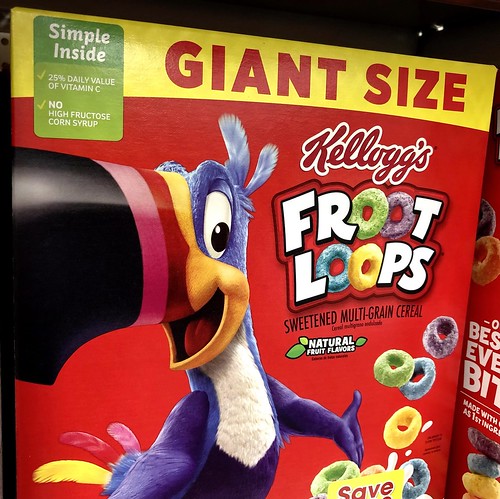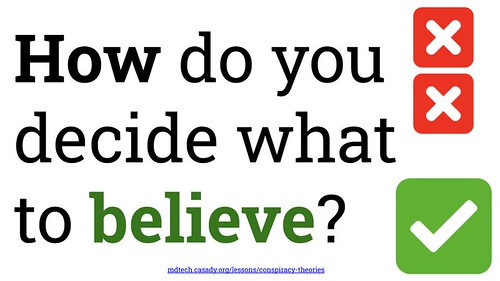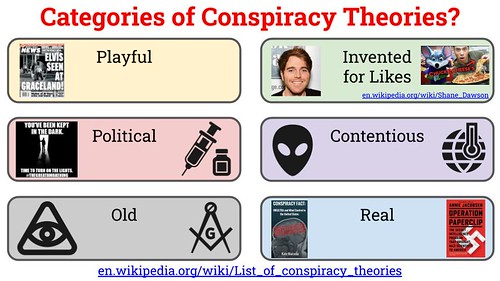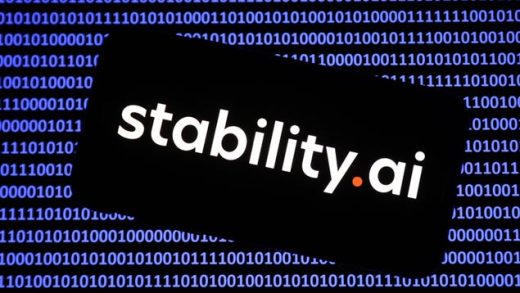Conspiracy theories are far more than an amusement today. The Annenberg Public Policy Center at the University of Pennsylvania this week released a study finding that a “Belief in Conspiracy Theories Is a Barrier to Controlling Spread of COVID-19.” Folks who profess beliefs in different outlier conspiracy theories today are more likely to reject mask wearing to prevent the spread of COVID-19, and are more likely to refuse to take a vaccine once one (or more) are released to the general public. Media Matters for America continues to update their article, “Here are the QAnon supporters running for Congress in 2020,” and their count as of this post on September 23rd is up to “81 current or former congressional candidates.” When you consider the heart of the QAnon conspiracy is that “a cabal of Satan-worshiping pedophiles running a global child sex-trafficking ring is plotting against President Donald Trump,” and these 81 candidates for the highest legislative body in our nation appear (“from a distance”) to otherwise be functioning adults in our society, it’s difficult to not experience some severe political and cultural cognitive dissonance.
Living as we do in highly polarized times, it can be exceptionally difficult to talk about political issues in class with students, even though the importance of learning how to engage in civil discourse and respectful listening to others who have different ideas than our own is essential for the functioning of a representative democracy. Excellent resources like those from The Choices Program at Brown University are available to help teachers engage students in productive conversations about controversial issues, but in our polarized political environment, the temptation is strong to avoid classroom discussion of issues which can invite emotional and angry responses from students, parents, and members of the community.
Conspiracy theories and culture wars are powerful and pervasive today, however, and those are some of the reasons Brian Turnbaugh (@wegotwits) and I started the “Conspiracies and Culture Wars Media Literacy Project” in Summer 2020. We co-presented a workshop on the project at the Summer Institute on Digital Literacy in July, and provided a variety of suggestions for classroom teachers wanting to address the multitude of media literacy, civics education, and citizenship issues raised by these headlines and polarizing dynamics today.
I also shared a keynote at the July “Mountain Moot” virtual conference on “Conspiracies and Culture Wars,” and focused more on “connecting the dots” of many news headlines and technology trends we see across our society today which involve not only conspiracy theories but also the weaponization of social media to pollute our information environment with disinformation and misinformation which has and continues to have destructive consequences across our globe.
Since I teach 5th and 6th grade media literacy in our school’s “middle division,” many of the issues highlighted by articles I’ve shared on Twitter using the #ConCW hashtag are not appropriate for classroom discussions. Brian and I wrestled with the question of “what’s developmentally appropriate to discuss with middle school students when it comes to conspiracy theories” this summer in the weeks leading up to The 2020 Summer Institute on Digital Literacy. One of the key conclusions and recommendations we came up with was to focus on the human moon landings in 1969 – 1972 by Apollo astronauts from the United States. While alarming numbers of survey respondents in Britain and elsewhere reportedly doubt that the moon landings were real (1 in 6 Britons, according to a February 2019 YouGov study), it still feels relatively safe and “mainstream” to teach about the truth, validity, and reliability of NASA’s Apollo space program and moon landings. While a classroom discussion prompt about QAnon or the upcoming 2020 Presidential election could likely invite heated responses from parents, hopefully a discussion about “moon hoax believers” and the Apollo moon landings would not.
One outcome of all those summer conversations, Streamyard published and archived podcasts, and project collaborations has been a 4 part unit on “Conspiracy Theories” which I just wrapped up this week with my 6th Grade students. All the lessons, resources, and materials on my school curriculum sharing website are licensed via Creative Commons, and I would love for you or any other educator on our planet to use and remix any of these lessons with your own students to have important conversations about conspiracy theories, critical thinking, “the playbook of outlier / ‘fruit loop’ conspiracy theorists,” media literacy, and more.

“Fruit Loops Cereal” (CC BY 2.0) by Wesley Fryer
Here’s one of the Adobe Spark powered narrated slideshow videos one of my students created as her culminating project for this unit on conspiracy theories. I’m encouraged by the ways our conversations and these studies helped her think more deeply and critically about how she decides what to believe or not believe on YouTube specifically and the Internet more generally.
I love the 9 minute video, “Conspiracy Theories and Crazy People,” by YouTuber James Rallison. (@theodd1sout) Many of my students already watch and know James’ videos, and he provided multiple onramps for our unit discussions about conspiracy theories during our day 1 activities. My 6th graders have been just getting started with “interactive writing” via our class blogs this year on WriteAbout.com. Discussing these ideas together and then reflecting about them via our blogs proved to be a great way to start this unit of inquiry and conversations about media literacy.
It also proved to be a good strategy to watch and discuss together two different “Moon Hoax” videos: One which is a “PRO Moon Hoax” / conspiracy theory video, and the second which is a “Moon Hoax Not” / conspiracy theory debunking video. Prior to watching the “PRO Moon Hoax” video example, we discussed “Common Characteristics of “Fruit Loop” Conspiracy Theories” which borrowed directly from John Cook’s work on climate change and COVID-19, “Coronavirus, ‘Plandemic’ and the seven traits of conspiratorial thinking.” (@johnfocook)
I recorded myself using the “Lesson Cast remote learning format” on day 3 of our unit, as we watched a video supporting the truth of the Apollo Moon landings, and explaining why it was not technically possible in 1969 to fake them. Of all the lessons and teaching days in this unit, this one contained the most “meat” and instructional content which I wanted to impart to students. That’s one of the reasons I recorded my class with my second section of students teaching that lesson.
In the slideshow I used for this day 3 lesson, I’m most proud of slides 2, 3 and 4.
How do you decide what to believe? (slide 2)

“How do you decide what to BELIEVE?” (CC BY 2.0) by Wesley Fryer
What are the different categories of conspiracy theories? (slide 3)

“Categories of Conspiracy Theories” (CC BY 2.0) by Wesley Fryer
Why are conspiracy theories appealing? (slide 4)

“Why are Conspiracy Theories Appealing” (CC BY 2.0) by Wesley Fryer
I used icons from The Noun Project on these slides, and drew ideas from the September virtual meeting of the #digiURI Media Club, which focused on (you guessed it…) “conspiracy theories!”
In the next few weeks, after I catch up on my grading and project assessment from this unit as well as our family oral history interview projects, I’ll record a podcast here and reflect in greater detail about more of my lessons learned from this unit.
Overall, I’m SO glad to have been able to teach and lead discussions with students on these topics this year! Since our 5th and 6th grade media literacy classes are just a trimester long (about 25 class meetings) I’ll be repeating this unit two more times this year… and I look forward to tweaking and adjusting things further. Overall, however, I’m VERY happy with these activities and the sequence of video content which we analyzed and learned with.
I want to offer a HUGE shout out of thanks to Brian Turnbaugh (@wegotwits), all the organizers and leaders of the #digiURI community and Summer Institute on Digital Literacy, as well as other academics and teachers generously sharing their ideas and research relating to conspiracy theories and media literacy.
It’s a great day to be a media literacy educator! For more of my resources and lesson ideas relating to media literacy, visit medialiteracy.wesfryer.com.

“Tips for Discussing Conspiracy Theories” (CC BY 2.0) by Wesley Fryer
If you enjoyed this post and found it useful, consider subscribing to Wes’ free, weekly newsletter. Generally Wes shares a new edition on Monday mornings, and it includes a TIP, a TOOL, a TEXT (article to read) and a TUTORIAL video. You can also check out past editions of Wes’ newsletter online free!
Did you know Wes has published several eBooks and “eBook singles?” 1 of them is available free! Check them out! Also visit Wes’ subscription-based tutorial VIDEO library supporting technology integrating teachers worldwide!
MORE WAYS TO LEARN WITH WES: Do you use a smartphone or tablet? Subscribe to Wes’ free magazine “iReading” on Flipboard! Follow Dr. Wesley Fryer on Twitter (@wfryer), Facebook and Google+. Also “like” Wes’ Facebook page for “Speed of Creativity Learning”. Don’t miss Wesley’s latest technology integration project, “Show With Media: What Do You Want to CREATE Today?”
Source : Tips for Discussing Conspiracy Theories with Students










